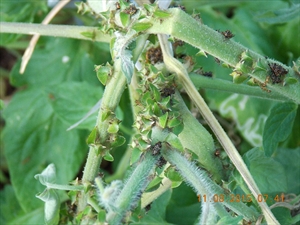Keeled treehopper
Pacific Pests, Pathogens, Weeds & Pesticides - Online edition
Pacific Pests, Pathogens, Weeds & Pesticides
Tomato keeled treehopper (248)
Antianthe expansa
Central, and North America (Hawaii), Oceania. It is recorded from Tonga.
Plants in the Solanaceae, including tomato capsicum and eggplant. Plants in the nightshade family are said to be wild hosts (e.g., Acnistus). Cape gooseberry (Physalis peruviana) is a host of the treehopper in Hawaii.
Eggs are laid in a double row of about 50 into slits cut by the female in woody branches and stems. The nymphs are reddish-brown with black spines, and the adults are about 5 mm long, green, with side extensions making them triangular-shaped from above (Photo 1). The back has a high ridge (the keel), the edge of which is black interspersed with light spots. The adults produce honeydew and attract ants.
The adults fly readily, but only for short distances. The eggs are either laid in the older, woody, parts of tomato, capsicum or eggplant stems, or in trees above them, in which case they fall to the plants below.
Large numbers of nymphs and adults occur on the succulent stems of hosts, sucking the sap and causing the stems and leaves to wilt and die (Photo 2). Damage also occurs when eggs are laid in splits in woody stems.
Look for the characteristic spiny reddish-black nymphs and the green keeled, triangular, adults, often in large numbers.
NATURAL ENEMIES
An egg parasitoid, a chalcid wasp, Anaphoidea sp., has been recorded, but it is not known if it or other parasitoids occur in Tonga.
Note that ants may need to be removed if the natural enemies are to be effective in controlling treehopper populations.
CULTURAL CONTROL
- Remove solanaceous wild hosts or plant at distance from extensive stands of them.
- Handpick the treehoppers when first seen.
CHEMICAL CONTROL
Use plant-derived products (see Fact Sheet no. 56), such as neem, derris, pyrethrum and chilli (with the addition of soap). Use horticultural oil (made from petroleum), white oil (made from vegetable oil), or soap solution (see Fact Sheet no. 56).
White oil:
- 3 tablespoons (1/3 cup) cooking oil in 4 litres water
- ½ teaspoon pure hand soap, not detergent
- Shake well and use.
Soap:
- Use soap (pure soap, not detergent):
- 5 tablespoons of soap in 4 litres water.
Commercial horticultural oils can also be used. White oil, soap and horticultural oil sprays work by blocking the breathing holes of insects causing suffocation and death. Oils and soaps must contact the insects.
If these are not effective use synthetic pyrethroids, but these will also kill natural enemies. Use synthetic pyrethroid insecticides to kill ants if they are present attracted to the honeydew.
--------------------
Note, derris (Derris species) contains rotenone, an insecticide, often used as a fish poison; it should be used with caution. The commercial derris insecticide is made from Derris elliptica.
____________________
When using a pesticide (or biopesticides), always wear protective clothing and follow the instructions on the product label, such as dosage, timing of application, and pre-harvest interval. Recommendations will vary with the crop and system of cultivation. Expert advice on the most appropriate pesticide to use should always be sought from local agricultural authorities.
AUTHOR Grahame Jackson
Information from King ABS, Saunders JL (1984) The invertebrate pests of annual food crops in Central America. Overseas Development Administration, London. Photos 1&2 Sione Foliaki, former Deputy Director and Head of Agricultural Research and Information Division, MAFFF, Tonga.
Produced with support from the Australian Centre for International Agricultural Research under project PC/2010/090: Strengthening integrated crop management research in the Pacific Islands in support of sustainable intensification of high-value crop production, implemented by the University of Queensland and the Secretariat of the Pacific Community.





